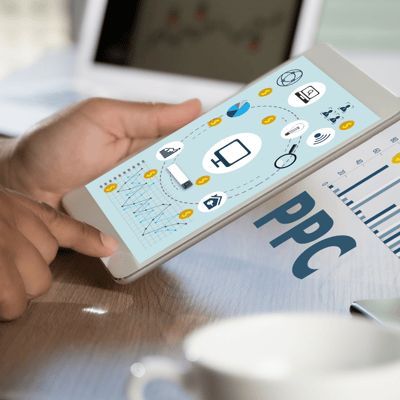Are you struggling to make your Google Ads campaigns a success? Don't worry, we've got you covered! In this blog, we will unlock the secrets to success with the five latest Google Ads features that can take your campaigns to new heights. But first, let's start with the basics.
What exactly is Google Ads and why should you advertise on it? We'll answer these questions and also address whether Google Ads really works. To help you navigate through the complex world of Google Ads, we've included a handy glossary of important terms.
Finally, we'll dive into how Google Ads actually works and share some tips on utilizing its PPC Kit effectively. Get ready to unlock the full potential of your Google Ads campaigns!
Unlocking Success with the Five Latest Google Ads Features
Maximize the success of your digital advertising campaigns by harnessing the power of the newest Google Ads features. With the introduction of Expanded Text Ads, you can create captivating and informative ads that resonate with your target audience. Google's Responsive Search Ads optimize your promotional content by experimenting with various combinations of headlines and descriptions, ensuring maximum impact.
Employ Smart Bidding to leverage cutting-edge machine learning technology, automatically adjusting your bids to drive conversions and enhance your return on investment (ROI). Target specific geographic locations with Local Campaigns, directing potential customers to your physical store and boosting foot traffic.
Take advantage of Custom Audiences to reach highly targeted segments, whether by uploading your own customer lists or tapping into Google's expansive audience targeting options. By leveraging these five features, you can unlock the true potential of Google Ads and achieve unrivaled success in your online advertising endeavors.
What is Google Ads?
Google Ads is an online advertising platform created by Google that enables businesses to create and display ads on Google search results and partner websites. It offers targeting options for keywords, demographics, locations, and interests. Various ad formats such as text, display, video, and shopping ads are available.
Why advertise on Google?
Advertising on Google is a smart choice because it helps you reach a massive pool of potential customers. Google, being the top search engine, has billions of daily searches. With Google Ads, you can precisely target your audience and pay only when someone clicks on your ad, making it a cost-effective advertising solution.

Does Google Ads work?
Yes, Google Ads can be a powerful tool for driving targeted traffic and generating leads. It allows you to reach a large audience and target specific demographics. By conducting thorough keyword research and optimizing campaigns, you can achieve a high ROI. However, regular monitoring and optimization are crucial for maximizing results.
Google Ads Terms to Know
As a marketer, it's crucial to familiarize yourself with the key terms used in Google Ads. Understanding these terms will help you optimize your campaigns and achieve better results. Here are some essential Google Ads terms you should know:
Smart Bidding: Google's automated bidding strategy uses machine learning to optimize bids for conversions or conversion value. By leveraging smart bidding, you can maximize your return on investment (ROI) without the need for manual bid adjustments.
Responsive Search Ads: These ads automatically adjust their size, format, and appearance to fit available ad space. As an advertiser, utilizing responsive search ads can enhance your ad's visibility and improve its performance across various platforms and devices.
Local Campaigns: These ad campaigns are designed to target users in specific locations and drive them to physical store visits or offline conversions. By implementing local campaigns, you can effectively reach your local target audience and boost foot traffic to your brick-and-mortar locations.
Audience Expansion Tool: This tool is a valuable asset for advertisers looking to expand their reach and find new potential customers. It identifies similar audiences to your existing customer base, allowing you to broaden your target audience and tap into untapped markets.
Video Action Campaigns: This feature empowers advertisers to drive more conversions from their video ads. By incorporating interactive elements like lead forms or calls-to-action, video action campaigns encourage viewer engagement and increase the likelihood of conversions.
1. Ad Extensions
Ad Extensions are crucial for enhancing your Google Ads and engaging potential customers. These extensions, such as phone numbers, locations, and relevant links, provide additional context and options. By increasing ad visibility and performance, Ad Extensions improve your campaign's success.
Key types of extensions, like call extensions, sitelink extensions, and location extensions, offer valuable opportunities to boost customer interaction. Regularly reviewing and optimizing your extensions is essential to align them with your advertising goals and maximize results. Discover the potential of Ad Extensions and optimize your Google Ads strategy for optimal performance.
2. AdRank
AdRank is a crucial metric used by Google to determine the position of your ad in search results. It takes into account various factors such as ad quality, relevance, bid amount, and the expected impact of ad extensions and other formats.
By optimizing your Quality Score, which is influenced by click-through rate and landing page experience, you can improve your AdRank. Achieving a higher AdRank can lead to better placement, increased visibility, and potentially more clicks and conversions. Understanding and optimizing for AdRank is essential for maximizing the effectiveness of your Google Ads campaigns.
3. Bidding
Ad bidding is a crucial aspect of maximizing the performance of your Google Ads campaign. It involves determining the amount you are willing to pay for each click on your ads. The bidding process includes different strategies, such as manual bidding, automated bidding, and target return on ad spend (ROAS) bidding.
Manual bidding provides full control over your bids, while automated bidding optimizes your bids through machine learning. Target ROAS bidding focuses on maximizing the conversion value based on a specific return on ad spend goal. Regular monitoring and adjustment of your bidding strategy are vital to achieving your advertising objectives and getting the best results.
4. Campaign Type
Google Ads provides a diverse range of campaign types to cater to various advertising objectives and goals. Whether you aim to boost website traffic, enhance brand awareness, or promote your mobile app, there is a campaign type perfectly suited for your needs.
The most widely used campaign types in Google Ads encompass Search campaigns, Display campaigns, Video campaigns, Shopping campaigns, and App campaigns. Each campaign type boasts unique features and precise targeting options to effectively reach and engage your desired audience.
Carefully selecting the appropriate campaign type that aligns with your specific advertising objectives and audience is paramount. Executing regular monitoring and optimization techniques will greatly contribute to ensuring your campaigns yield the desired outcomes.
5. Click-Through Rate (CTR)
Click-Through Rate (CTR) is a vital metric in Google Ads optimization. It indicates the percentage of users who click on your ad after viewing it. Higher CTR suggests engaging and relevant ad content. Evaluating CTR is important for monitoring ad performance and making necessary improvements.
Enhanced CTR can be achieved through strategic ad copy optimization, precise keyword targeting, and a seamless landing page experience. By leveraging CTR, marketers can fine-tune their Google Ads campaigns for increased visibility, relevance, and potential customer acquisition. Boost your ad performance with a high Click-Through Rate (CTR) today!
6. Conversion Rate (CVR)
The Conversion Rate (CVR) is an essential metric in Google Ads campaigns. It plays a vital role in measuring the effectiveness of your ads in driving desired actions, such as purchases or form submissions. By monitoring and optimizing your CVR, you can enhance the performance of your Google Ads campaigns and maximize your return on investment (ROI).
A high CVR indicates that your ads are resonating with your target audience and successfully prompting them to take action. On the other hand, a low CVR may indicate areas for improvement in your ad messaging or landing page optimization. By focusing on improving your CVR, you can ensure your ads are delivering better results and achieving higher conversions.
7. Display Network
Expand your reach with the Display Network, a collection of websites, apps, and videos, that goes beyond search results. Target your audience on relevant platforms with visually appealing text, image, video, or interactive ads. Increase brand awareness, drive website traffic, and connect with potential customers browsing relevant content.
With the Display Network, you can enhance your digital marketing efforts and maximize your visibility. Reach customers on websites and videos related to your business, making an impact with engaging ad formats. Elevate your advertising with the Display Network, expanding your reach in the digital landscape.
8. Impressions
Impressions in Google Ads serve as a vital metric to gauge the visibility and reach of your ad campaign. They represent the number of times your ad appears on search engine results pages (SERPs) and various platforms.
While impressions alone don't guarantee engagement, they provide insights into your ad's exposure to potential customers. By monitoring impressions alongside other crucial metrics like click-through rate (CTR) and conversions, you can make informed decisions to optimize your Google Ads campaign and maximize ROI. This metric helps you understand how effectively your ads are reaching your target audience, enhancing your overall campaign performance.
9. Keywords
Keywords play a crucial role in achieving success with Google Ads. Advertisers leverage carefully chosen, relevant, and specific keywords to align their campaigns with their business objectives and target audience. Google Ads offers a range of keyword match types – broad match, phrase match, exact match, and negative match – enabling advertisers to fine-tune their targeting.
By conducting thorough keyword research and analyzing search term reports, marketers uncover high-performing keywords and optimize their campaigns for maximum ROI. Continuous monitoring and updating of keyword strategies, driven by performance data and shifting user behavior, are essential for staying ahead in the competitive Google Ads landscape.
10. PPC
PPC, a popular online advertising method adopted by Google Ads, enables businesses to boost their visibility and drive more targeted traffic. By bidding on relevant keywords, advertisers can showcase their ads, pay only when someone clicks, and better manage their budget.

This pay-per-click approach proves highly effective in enhancing brand awareness, generating leads, and boosting sales. To maximize their ROI, advertisers must continuously optimize their PPC campaigns, analyzing key metrics such as CTR and CVR. By monitoring these metrics and leveraging data from Google Analytics and their Google Ads account, marketers can refine their ads, targeting, and landing pages to achieve better results.
11. Quality Score (QS)
The Quality Score (QS) is a vital metric used by Google Ads to assess the quality and relevance of ads, keywords, and landing pages. It considers factors such as ad relevance, click-through rate (CTR), and landing page experience.
A higher QS can result in better ad positions and lower costs, improving the performance and ROI of your Google Ads campaign. To optimize your Quality Score, focus on refining your keywords, ad copy, and landing pages to align with your target audience's queries. Continuous monitoring and optimization of the Quality Score can enhance the effectiveness of your Google Ads campaigns, ensuring better visibility and conversions.
How does Google Ads work?
Google Ads is an online advertising platform where advertisers bid to display their ads on relevant search results and websites. Advertisers choose keywords, create campaigns, and set a budget. When a user searches for a keyword, Google matches the query with relevant ads. Advertisers pay when someone clicks on their ad or when it receives impressions.
1. Advertisers bid on keywords in Google ads.
Google Ads bidding plays a significant role in driving successful advertising campaigns on Google. Advertisers engage in bidding on relevant keywords, thereby ensuring their ads are displayed in search results and on relevant websites. They create strategically targeted campaigns, tailoring their reach to their specific audience.
When a user initiates a search matching an advertiser's bid, the ad enters an auction where its position is influenced by factors including bid amount, quality score, and anticipated impact of ad extensions and other formats. Advertisers are only billed for actual clicks or when their ad garners a set number of impressions.
2. The potential customer searches for a keyword in Google.
When potential customers type in a keyword on Google, they set off a search process that aims to connect them with relevant solutions and information. In this process, Google Ads plays a vital role by displaying targeted ads that match the user's search query.
Through an auction-based system, Google determines which ads appear based on factors like ad relevance, quality, and bid amounts from advertisers. These ads can be seen at the top of the search results page or on relevant websites across the advertising network. By engaging with these ads, potential customers can explore businesses' offerings, and take the necessary steps to make a purchase or find the desired information they seek
Conclusion
In conclusion, staying up-to-date with the latest features and advancements in Google Ads can significantly impact the success of your advertising campaigns. By leveraging features such as ad extensions, understanding metrics like AdRank and click-through rate (CTR), and optimizing your campaign type and keywords, you can unlock the full potential of Google Ads.
It's important to continuously monitor and adjust your ads based on performance metrics to maximize your return on investment. Reach out to our experts today for more information.








